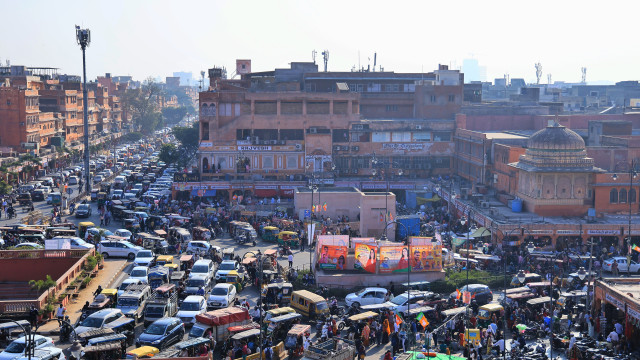





























See Also
See Again
© Getty Images
0 / 30 Fotos
Mass immigration
- In the 19th century, thousands of people emigrated to the US. In New York City alone, the population roughly doubled every 20 years for most of the 1800s.
© Getty Images
1 / 30 Fotos
Tenements
- Many ended up living in small, narrow, low-rent apartment buildings known as tenements.
© Getty Images
2 / 30 Fotos
Crammed
- New York City's tenement buildings were previously occupied by single families, but high demand for accommodation turned them into multiple-occupancy buildings.
© Getty Images
3 / 30 Fotos
Definition
- New York State Legislature from 1867 defined a tenement as "any building…which is rented…out as the home of more than three families living independently of one another and doing their own cooking upon the premises."
© Getty Images
4 / 30 Fotos
Lower East Side
- Many of these tenements were concentrated in Manhattan's Lower East Side. Pictured is Delancey Street.
© Getty Images
5 / 30 Fotos
Shanty towns
- By the turn of the century, around 2.3 million people (two-thirds of NYC's population) were living in tenement housing. Many others were also living in shanty towns built around tenement areas.
© Getty Images
6 / 30 Fotos
They were small
- The individual apartments were around 300-400 square feet (27-38 square meters). Large families were packed into these tiny spaces.
© Getty Images
7 / 30 Fotos
Disease was rampant
- Sanitation and hygiene were poor. Diseases such as smallpox and tuberculosis would rapidly spread among residents.
© Getty Images
8 / 30 Fotos
Poor sanitation
- Flowing water, toilets, showers, or baths, were non-existent. Most tenants would use a common faucet in the backyard where they'd get water to wash themselves, cook, and everything else.
© Getty Images
9 / 30 Fotos
Air and light
- Poor ventilation and lighting were also issues residents had to endure.
© Getty Images
10 / 30 Fotos
No electricity
- It was not until 1918, that legislation was passed to make it compulsory for electricity to be installed in the apartments.
© Getty Images
11 / 30 Fotos
Fire was a threat
- Fire was a constant threat in tenements. Fire escapes were eventually installed in some of the buildings after the 1867 Tenement Act came into effect.
© Getty Images
12 / 30 Fotos
Work spaces
- In addition to being crowded living spaces, New York City's tenements were also used as places of work but the tenants.
© Getty Images
13 / 30 Fotos
Work spaces
- The manufacturing of clothing, accessories, and food, among other services, was common.
© Getty Images
14 / 30 Fotos
Work spaces
- Pictured are tailors at work in a NYC tenement.
© Getty Images
15 / 30 Fotos
Not everyone could afford tenement housing
- It was not unusual for tenants to place beds or mattresses on the floor and rent them out for a few pennies a night.
© Getty Images
16 / 30 Fotos
Very high population density
- In 1894, the New York State Assembly Tenement House Committee found 38,000 tenement buildings in New York.
© Getty Images
17 / 30 Fotos
New York City's tenements
- By then, the Lower East Side had up to 700 residents per acre (4,047 square meters).
© Getty Images
18 / 30 Fotos
Urban renewal
- The 1901 Tenement Housing Act changed a few things with regards to space and safety regulations, and it marked the beginning of the end for tenements.
© Getty Images
19 / 30 Fotos
Urban renewal
- The Urban Renewal federal program catalyzed the demolition of many buildings, and by the 1950s New York City had changed considerably. Let's take a look at a few more pictures of life in New York City's tenements.
© Getty Images
20 / 30 Fotos
Native American family
- A Native American family makes handicrafts while one son plays violin in their tenement.
© Getty Images
21 / 30 Fotos
Back alley
- Children play with marbles in a back alley in New York City.
© Getty Images
22 / 30 Fotos
Man in bed
- A man lies in bed in his tenement apartment in NYC.
© Getty Images
23 / 30 Fotos
Family
- A family is pictured in their tenement home in New York City, circa 1914.
© Getty Images
24 / 30 Fotos
A shabby home
- A room in a tenement house in New York City. Furniture was basic and living conditions were poor.
© Getty Images
25 / 30 Fotos
Shacks
- Men sit outside their shacks in New York City in the early 1900s.
© Getty Images
26 / 30 Fotos
Tenement houses
- Tenement houses on Mulberry Street in Manhattan, circa 1900.
© Shutterstock
27 / 30 Fotos
Tenement complex
- A tenement complex in Bottle Alley, New York City, in 1901.
© Getty Images
28 / 30 Fotos
Working class women
- Residents of a tenement on Henry Street, Lower East Side. Sources: (History) (History Collection) (All That’s Interesting) (Skyscraper Museum) (Window to the World)
© Getty Images
29 / 30 Fotos
© Getty Images
0 / 30 Fotos
Mass immigration
- In the 19th century, thousands of people emigrated to the US. In New York City alone, the population roughly doubled every 20 years for most of the 1800s.
© Getty Images
1 / 30 Fotos
Tenements
- Many ended up living in small, narrow, low-rent apartment buildings known as tenements.
© Getty Images
2 / 30 Fotos
Crammed
- New York City's tenement buildings were previously occupied by single families, but high demand for accommodation turned them into multiple-occupancy buildings.
© Getty Images
3 / 30 Fotos
Definition
- New York State Legislature from 1867 defined a tenement as "any building…which is rented…out as the home of more than three families living independently of one another and doing their own cooking upon the premises."
© Getty Images
4 / 30 Fotos
Lower East Side
- Many of these tenements were concentrated in Manhattan's Lower East Side. Pictured is Delancey Street.
© Getty Images
5 / 30 Fotos
Shanty towns
- By the turn of the century, around 2.3 million people (two-thirds of NYC's population) were living in tenement housing. Many others were also living in shanty towns built around tenement areas.
© Getty Images
6 / 30 Fotos
They were small
- The individual apartments were around 300-400 square feet (27-38 square meters). Large families were packed into these tiny spaces.
© Getty Images
7 / 30 Fotos
Disease was rampant
- Sanitation and hygiene were poor. Diseases such as smallpox and tuberculosis would rapidly spread among residents.
© Getty Images
8 / 30 Fotos
Poor sanitation
- Flowing water, toilets, showers, or baths, were non-existent. Most tenants would use a common faucet in the backyard where they'd get water to wash themselves, cook, and everything else.
© Getty Images
9 / 30 Fotos
Air and light
- Poor ventilation and lighting were also issues residents had to endure.
© Getty Images
10 / 30 Fotos
No electricity
- It was not until 1918, that legislation was passed to make it compulsory for electricity to be installed in the apartments.
© Getty Images
11 / 30 Fotos
Fire was a threat
- Fire was a constant threat in tenements. Fire escapes were eventually installed in some of the buildings after the 1867 Tenement Act came into effect.
© Getty Images
12 / 30 Fotos
Work spaces
- In addition to being crowded living spaces, New York City's tenements were also used as places of work but the tenants.
© Getty Images
13 / 30 Fotos
Work spaces
- The manufacturing of clothing, accessories, and food, among other services, was common.
© Getty Images
14 / 30 Fotos
Work spaces
- Pictured are tailors at work in a NYC tenement.
© Getty Images
15 / 30 Fotos
Not everyone could afford tenement housing
- It was not unusual for tenants to place beds or mattresses on the floor and rent them out for a few pennies a night.
© Getty Images
16 / 30 Fotos
Very high population density
- In 1894, the New York State Assembly Tenement House Committee found 38,000 tenement buildings in New York.
© Getty Images
17 / 30 Fotos
New York City's tenements
- By then, the Lower East Side had up to 700 residents per acre (4,047 square meters).
© Getty Images
18 / 30 Fotos
Urban renewal
- The 1901 Tenement Housing Act changed a few things with regards to space and safety regulations, and it marked the beginning of the end for tenements.
© Getty Images
19 / 30 Fotos
Urban renewal
- The Urban Renewal federal program catalyzed the demolition of many buildings, and by the 1950s New York City had changed considerably. Let's take a look at a few more pictures of life in New York City's tenements.
© Getty Images
20 / 30 Fotos
Native American family
- A Native American family makes handicrafts while one son plays violin in their tenement.
© Getty Images
21 / 30 Fotos
Back alley
- Children play with marbles in a back alley in New York City.
© Getty Images
22 / 30 Fotos
Man in bed
- A man lies in bed in his tenement apartment in NYC.
© Getty Images
23 / 30 Fotos
Family
- A family is pictured in their tenement home in New York City, circa 1914.
© Getty Images
24 / 30 Fotos
A shabby home
- A room in a tenement house in New York City. Furniture was basic and living conditions were poor.
© Getty Images
25 / 30 Fotos
Shacks
- Men sit outside their shacks in New York City in the early 1900s.
© Getty Images
26 / 30 Fotos
Tenement houses
- Tenement houses on Mulberry Street in Manhattan, circa 1900.
© Shutterstock
27 / 30 Fotos
Tenement complex
- A tenement complex in Bottle Alley, New York City, in 1901.
© Getty Images
28 / 30 Fotos
Working class women
- Residents of a tenement on Henry Street, Lower East Side. Sources: (History) (History Collection) (All That’s Interesting) (Skyscraper Museum) (Window to the World)
© Getty Images
29 / 30 Fotos
Life in New York's early 1900s slums: A photographic history
Thousands of people lived in shocking conditions
© Getty Images
By the end of the 18th century, New York City's population had grown exponentially with thousands of immigrants looking for a better life in America. Many ended up settling down in the Big Apple and lived crammed into dilapidated apartment buildings known as tenements. Living conditions were dreadful in most of these apartments, but for thousands of people, this was home.
In this gallery, we bring you a glimpse of what life in a New York City tenement was like. Click on.
RECOMMENDED FOR YOU




































MOST READ
- Last Hour
- Last Day
- Last Week








